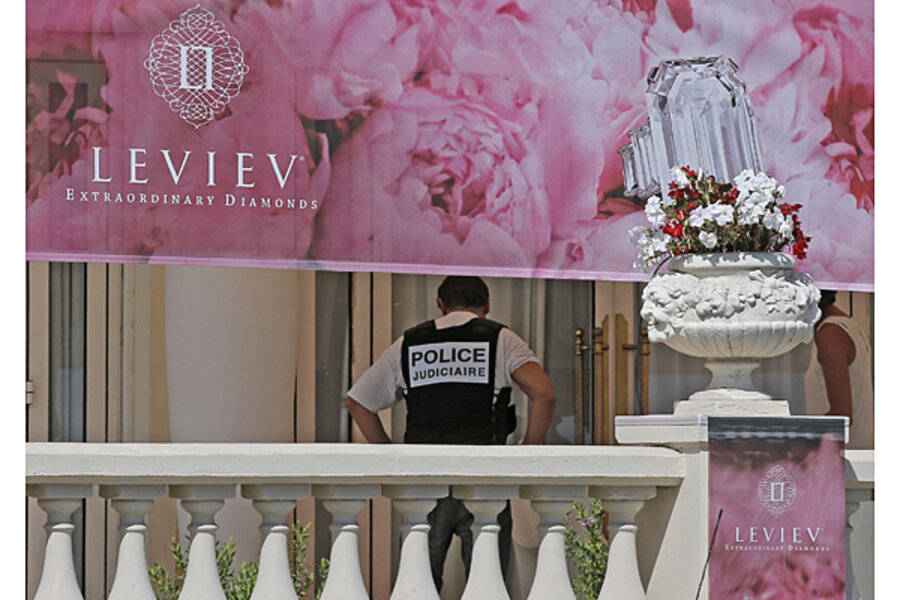Cannes jewel heist: $53 million in diamonds, jewels stolen from hotel
Loading...
| Paris
A staggering 40 million euro ($53 million) worth of diamonds and other jewels was stolen Sunday from the Carlton Intercontinental Hotel in Cannes, in one of Europe's biggest jewelry heists in recent years, police said. One expert noted the crime follows recent jail escapes by members of the notorious "Pink Panther" jewel thief gang.
The hotel in the sweltering French Riviera was hosting a temporary jewelry exhibit over the summer from the prestigious Leviev diamond house, which is owned by Israeli billionaire Lev Leviev.
A police spokesman said the theft took place around noon, but he could not confirm local media reports that the robber was a single gunman who stuffed a suitcase with the gems before making a swift exit. The spokesman spoke on condition of anonymity because he was not authorized to discuss the matter on the record.
The luxury Carlton hotel featured prominently in Alfred Hitchcok's "To Catch a Thief," which starred Cary Grant as a reformed burglar chasing a jewel thief. It is situated on the exclusive Promenade de la Croisette that stretches a mile and a half (2.4 kilometers) along the French Riviera, and is thronged by the rich and famous throughout the year. The hotel's position provides not only a beautiful view of the sea but also an easy getaway for potential jewel thieves along the long stretch of road.
"It's a huge theft. Anytime you talk about a heist with many millions of dollars it turns heads and feeds the imagination," said Jonathan Sazonoff, U.S. editor for the Museum Security Network website and an authority on high-value crime.
He said the likelihood of recovering the stolen diamonds and jewels is slim, because the thieves can easily sell them. "The fear is, if you're dealing with high-quality minerals, it's hard to get them back," Sazonoff said. "They can be broken up and so they can be easily smuggled and sold."
The valuable gems were supposed to be on public display until the end of August. It was not immediately clear how many pieces were stolen.
Leviev, in a brief statement, said: "Company officials are cooperating with local authorities investigating the loss and are relieved that no one was injured in the robbery."
Several police officers were placed in front of the Carlton exhibition room — near a Cartier diamond boutique — to prevent the dozens of journalists and photographers from getting a look at the scene of the crime.
Hotel officials would not comment, and attempts to get comments from Leviev or his company were not immediately successful.
Europe has been struck by several brazen jewelry thefts in recent years, some of which have involved tens of millions of dollars in treasure.
On Feb. 18 in Belgium, some $50 million worth of diamonds were stolen. In that heist, robbers targeted stones from the global diamond center of Antwerp that had been loaded on a plane headed to Zurich. Authorities have since detained dozens of people and recovered much of the items stolen in that operation.
Five years ago, in December 2008, armed robbers wearing women's wigs and clothing made off with diamond rings, gem-studded bracelets and other jewelry said then to be worth $108 million from a Harry Winston boutique in Paris.
Also in 2008 — in February of that year — in a scene reminiscent of the movie "The Italian Job," masked thieves drilled a tunnel into a Damiani jewelry company showroom in Milan, Italy. They tied up the staff with plastic cable and sticky tape, then made off with gold, diamonds and rubies worth some $20 million. The robbers had been digging for several weeks from a building under construction next door.
Cannes appears to be a favorite target this year — in May it was struck by other two highly publicized jewelry heists during the CannesFilm Festival.
In the first theft, robbers stole about $1 million worth of jewels after ripping a safe from the wall of a hotel room. In the second, thieves outsmarted 80 security guards in an exclusive hotel and grabbed a De Grisogono necklace that creators said is worth 2 million euros ($2.6 million).
Sazonoff said it is normal for robbers to gravitate to a place like Cannes, whose glimmering harbor and glamorous film festival attract the world's rich and famous. "Why do thieves target Cannes? It's simple ... On the Cote d'Azur, it's where the monied people flow," he said.
Sazonoff also said police would likely probe whether Sunday's heist is linked to recent jail escapes by alleged members of the Pink Panther jewel thief gang.
On Thursday, gang member Milan Poparic escaped his Swiss prison after accomplices rammed a gate and overpowered guards with bursts from their AK-47s, police said.
Police say the Pink Panther network's members are prime suspects in a series of daring thefts. According to Interpol, the group has targeted luxury watch and jewelry stores in Europe, the Middle East, Asia and the United States, netting more than €330 million (£285m) since 1999.
Poparic is the third member of the Pink Panthers to escape from a Swiss prison in as many months, according to Vaud police.
"The brazen drama of it is their style... The possibility of the reemergence of the Pink Panther gang is very troubling and taken seriously by law enforcement worldwide," Sazonoff said. "The theft of high value diamonds is exactly what they do, so it's not a great leap to assume they are on the warpath again. They are a crime wave waiting to happen."







